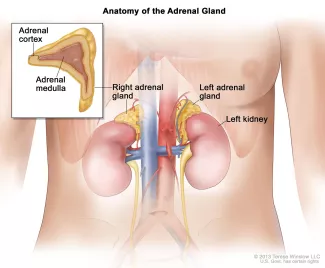Conn's Syndrome

Conn's syndrome is a condition associated with the development of high blood pressure in the presence of low potassium levels in the blood. This is usually due to the presence of a tumor in the adrenal cortex, the outer part of the adrenal gland.

The tumor causes excessive amounts of the hormone aldosterone to be released. This is also called hyperhyperaldosteronism (Conn syndrome). Aldosterone is a hormone that helps to regulate the amount of salt in the body. In patients who have overproduction of this hormone, excessive salt is retained and potassium lost, leading to high blood pressure and low potassium levels.
Not all patients with a Conn's syndrome have a visible tumor in imaging, or they may have bilateral thickened adrenal glands. In some patients, the abnormal function of the adrenal cortex results from a less serious condition called adrenal hyperplasia. However, this may ultimately lead to Conn's syndrome.
Establishing the clear diagnosis of hyperaldosteronism
Diagnosis of hyperaldosteronism is made by hormonal evaluations and may require specialized testing, such as salt loading, if the diagnosis is not clear. Once the diagnosis is made by biochemical evaluation, imaging of the adrenals is indicated.
Computed Tomography (CT or CAT Scan) of the adrenal glands can diagnose all but the smallest tumors that causes Conn's syndrome.
Where diagnosis is suspected, i.e. the patient has both high blood pressure and low potassium levels, but the tumor is not seen on CT scan, a test called adrenal selective venous sampling for aldosterone may provide the diagnosis. A radiologist inserts a small catheter into the adrenal vein to measure the amount of aldosterone in the blood. In patients with a tumor, the side with the tumor will show excessive amounts of aldosterone compared to the others adrenal gland.
Treatment
Surgical removal of the adrenal gland that harbors the culprit tumor is the definitive treatment for Conn's syndrome. The procedure, called an adrenalectomy, usually improves or may even cure the high blood pressure and often cures the low potassium levels, which usually return to normal in most patients. Occasionally, in patients with longstanding tumors, persistent elevation in blood pressure continues after surgery because of damage to blood vessels in general. In patients with only adrenal hyperplasia, surgery is often not recommended, and medical treatment is better.
In most cases, a laparoscopic or PRA adrenalectomy can be performed; these are both minimally invasive surgery using tiny incisions and a small scope connected to a video camera. The camera sends a magnified image from inside the body to a monitor, giving the surgeon a close-up view of the adrenal anatomy. The surgeon then operates manipulating miniature surgical instruments that were passed through the scope.
Minimally invasive adrenalectomy has key advantages for patients including:
- Less post-operative pain
- Faster recovery from surgery
- Shorter hospital stay
- A more rapid return to work and normal activities
For additional adrenalectomy information, please see related conditions & procedures:
